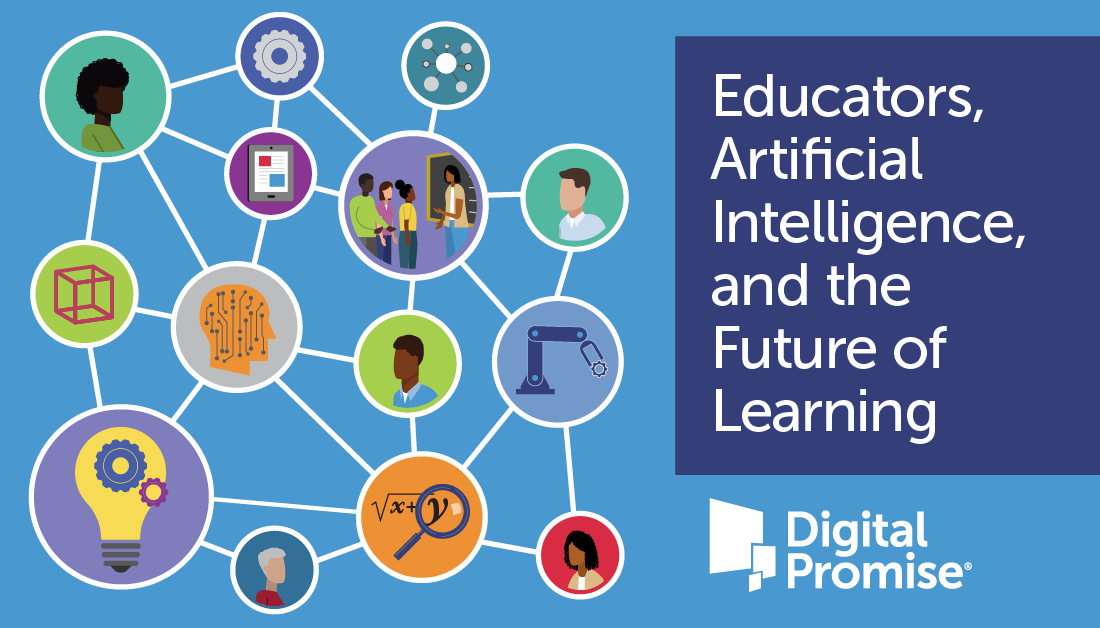
By Sarah Hampton
On April 21, I was able to participate in something really exciting! I joined some amazing researchers and former teachers in the Educators, Artificial Intelligence, and the Future of Learning webinar on Learning Environments facilitated by James Lester. The webinar was designed to help practitioners, AI researchers, and developers share their perspectives on how artificial intelligence can be used in the classroom. As you may know, I am a middle and secondary math teacher. My fellow panelists included:
- Diane W. Doersch, Technical Project Director, Digital Promise
- Cindy Hmelo Silver, Learning and Technology Researcher, Indiana University
- Kylie Peppler and Emily Schindler, Learning and Technology Researchers, University of California, Irvine
The webinar focused on how AI can enhance learning environments. It started with James who discussed the advancements in educational AIs during his 25 years of work in the field, the significant benefit they can provide, and the current demand for AI in educational settings. In other words, this is a hot topic in education right now!
Next, Diane Doersch shared her thoughts on AI in education, drawing from her experiences as a former classroom teacher, a Director of Technology for a large school district, and Chief Technology and Information Officer. She called for optimism yet caution and thoughtful vetting processes before incorporating AI in classrooms. She also stressed how important it is for school decision makers to know and understand what artificial intelligence is and the impacts that it has in order to properly vet products.
In this initial post, I want to camp out on Diane’s thoughts; we’ll discuss Cindy Hmelo-Silver and Kylie Peppler and Emily Schindler’s work in later posts. At Educator CIRCLS, we’ve really been digging into artificial intelligence so we can participate in the important conversation happening right now around how AI can be used in classrooms, and, perhaps more importantly, when AI should and shouldn’t be used in classrooms. We want to offer our educator perspectives to the communities developing, researching, and creating policy around AI in education. Furthermore, we want you to understand artificial intelligence so you can offer your unique perspectives and advocate for your students, too. Our friends at Digital Promise recently posted Artificial Intelligence 101: Covering the Basics for Educators. It’s a great introduction to AI and has points to ponder for veteran AI folks, too.
I’ve spent a lot of time reflecting since the webinar. I’ve specifically been thinking about things to consider when making purchasing and/or adoption decisions for AI products. Diane and I offered some suggestions during the webinar (timestamp 39:55), and I have added more below. You will notice some common themes from AI 101 and from this school procurement guide by Edtech Equity. I hope these can be useful resources for you and your school decision makers as you’re sure to see more and more AI products coming your way!
Is it safe? Is it secure? Is it ethical?
- How is the company funded? Do they sell the data they collected? How is the data safeguarded?
- What was the training data for the AI like? Was it sufficient in volume and diversity? Has it had adversarial training?
- What was the fitness model like when training the AI? What was the goal and how was fitness measured?
- What are the consequences if the AI fails? How does it fail?
Does it align with the mission of the district/school?
- Does it promote the kind of district/school culture you want?
- Does it create a significantly better learning experience that you couldn’t gain otherwise? Will it lead to substantial time saving or learning gains or meaningful learning experiences? Is it more than a wow factor?
- Does it promote the kind of assessments and standards you want to grow toward, or does it increase performance on your current assessments and standards?
Is it classroom/teacher friendly?
- Was it developed in collaboration with teachers? If not, it might work really well in the lab but may not extend to the complexity of a real classroom.
- Has it been tested in a classroom context similar to your own?
- Can the teacher override the AI if necessary?
- Does the tool free up the teacher to do what the teacher does best? You don’t want to offload what humans do best onto a machine. You want to maximize what machines do best and what people do best.
- Does the tool have a thoughtful approach to classroom management?
- Does the tool have a simple but thoughtful teacher dashboard?
- Will implementing the tool require teachers to change their pedagogy? If so, what supports, training, and time will be offered to make that shift successful?
- Does it promote the kind of classroom culture/activities you want? For example, does it help with collaboration, critical thinking, engaging all students, etc.?
What do you think? Did I leave something out? Feel free to tweet us @EducatorCIRCLS with any comments or suggestions! Stay tuned for future posts unpacking important topics from the webinar and sign up for the CIRCLS newsletter to stay updated on emerging technologies for teaching and learning. I’ll leave you with a question Diane posed, “If AI is the solution, then what’s the problem we’re trying to solve?”
Related
We also have resources from the other webinars in this series and additional posts on AI.
How to cite this work
CIRCL Educator posts are licensed under a Creative Commons Attribution 4.0 International License. If you use content from this site, please cite the post and consider adding: "Used under a Creative Commons Attribution 4.0 International License (http://creativecommons.org/licenses/by/4.0/)."
Suggested citation format: [Authors] ([Year]). [Title]. CIRCLEducators Blog. Retrieved from [URL]
